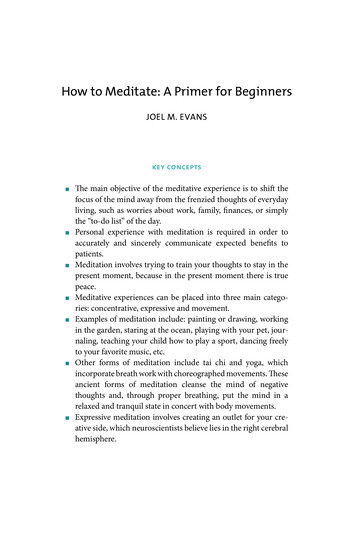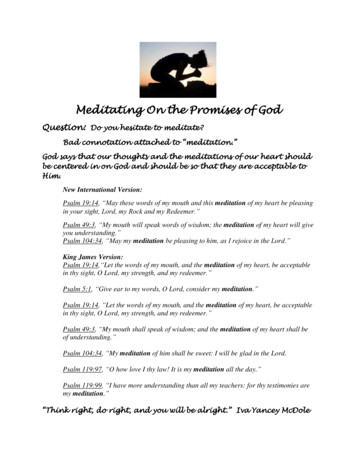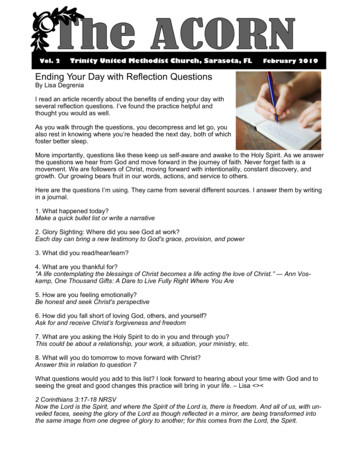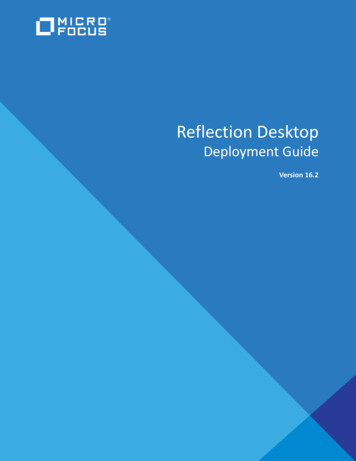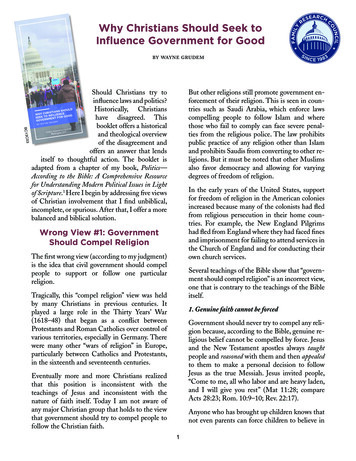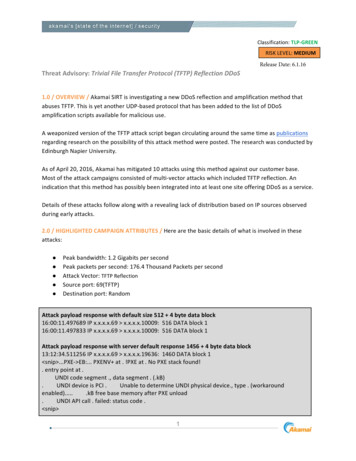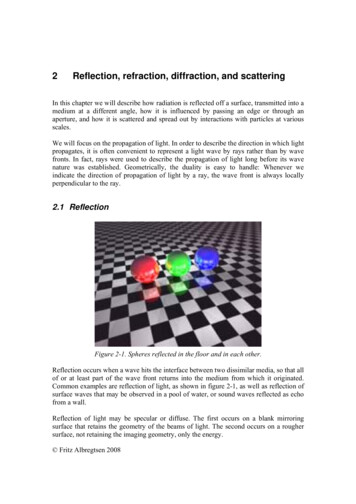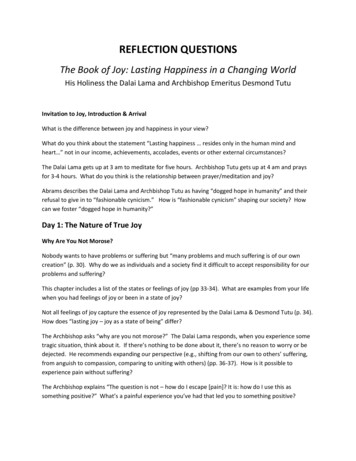
Transcription
REFLECTION QUESTIONSThe Book of Joy: Lasting Happiness in a Changing WorldHis Holiness the Dalai Lama and Archbishop Emeritus Desmond TutuInvitation to Joy, Introduction & ArrivalWhat is the difference between joy and happiness in your view?What do you think about the statement “Lasting happiness resides only in the human mind andheart ” not in our income, achievements, accolades, events or other external circumstances?The Dalai Lama gets up at 3 am to meditate for five hours. Archbishop Tutu gets up at 4 am and praysfor 3-4 hours. What do you think is the relationship between prayer/meditation and joy?Abrams describes the Dalai Lama and Archbishop Tutu as having “dogged hope in humanity” and theirrefusal to give in to “fashionable cynicism.” How is “fashionable cynicism” shaping our society? Howcan we foster “dogged hope in humanity?”Day 1: The Nature of True JoyWhy Are You Not Morose?Nobody wants to have problems or suffering but “many problems and much suffering is of our owncreation” (p. 30). Why do we as individuals and a society find it difficult to accept responsibility for ourproblems and suffering?This chapter includes a list of the states or feelings of joy (pp 33-34). What are examples from your lifewhen you had feelings of joy or been in a state of joy?Not all feelings of joy capture the essence of joy represented by the Dalai Lama & Desmond Tutu (p. 34).How does “lasting joy – joy as a state of being” differ?The Archbishop asks “why are you not morose?” The Dalai Lama responds, when you experience sometragic situation, think about it. If there’s nothing to be done about it, there’s no reason to worry or bedejected. He recommends expanding our perspective (e.g., shifting from our own to others’ suffering,from anguish to compassion, comparing to uniting with others) (pp. 36-37). How is it possible toexperience pain without suffering?The Archbishop explains “The question is not – how do I escape [pain]? It is: how do I use this assomething positive?” What’s a painful experience you’ve had that led you to something positive?
Page 2Nothing Beautiful Comes Without Some SufferingThe Archbishop says if you set out to be joyful – you won’t end up being joyful. What does that mean toyou?The Archbishop explains “it is how we face all of the things that seem to be negative in our lives thatdetermines the kind of person we become. If we regard all of this as frustrating, we’re going to comeout angry and wishing to smash everything . nothing beautiful comes out without a measure ofsome pain, some frustration, some suffering (pp. 44-45). What do you do inside yourself not to feelangry, fearful or self-pity or to complain?The Archbishop and Dalai Lama disagree on how much control we have over our emotions. TheArchbishop says we have very little while the Dalai Lama says we have more than we think (p. 46). Whatdo you think?Self-absorption leads to suffering. “Obsessing about getting what you want and avoiding what you don’twant does not result in happiness” (p. 48). “We have to take care of ourselves without selfishly takingcare of ourselves” (p. 47). How do you know when you’ve crossed the line?Buddhism teaches joy is our natural state and that the ability to experience joy can be cultivated as askill (p. 48). A study identifies three factors that seem to have the greatest influence on increasinghappiness: our ability to reframe our situation more positively, our ability to experience gratitude andour choice to be kind & generous (p. 49). How have you used these three factors in your life?Have You Renounced Pleasure?There is a difference between taking pleasure from external stimuli (e.g., music, sex, food, sports andentertainment) and pleasure from the mind. Physical pleasure is limited and brief and does not lead tohappiness. Happiness from the mind, love, compassion, generosity, leads to more lasting fulfilment. Itisn’t that one is right and the other wrong; rather it’s an issue of balance (pp. 52-54). How do youcultivate love, compassion, generosity, strength, peace and so on that lead to fulfilment?“ the more we experience any pleasure, the more we become numb to its effects and take itspleasures for granted .it is like a drug that must be taken in ever-greater quantities to produce thesame high (p. 55). What’s your experience of this?There are four “circuits” of the brain: the ability to maintain positive states, the ability to recover fromnegative states, our ability to focus and the ability to be generous. Which of these circuits are mostdeveloped in you? Which do you want to strengthen?As humans, we have three often unconscious goals: to survive, reproduce and cooperate, especiallywith our caregivers. As a result of these unconscious goals, we are more wary of others who aredifferent from us. Archbishop Tutu and the Dalai Lama constantly remind us that all humans are ourbrothers and sisters (p. 57). How can we as individuals and groups extend our need to cooperate topeople who are different than us?
Page 3Our Greatest JoyWe are wired to be compassionate, caring and generous to one another. “We shrivel when we areunable to interact .A person is a person through other persons.” This requires trust (pp. 59-62). Howdo you develop trust in others in today’s polarized environment?If one of the foundations of joy is going beyond self-centeredness, then is it selfish and self-defeating tofocus on our own joy and happiness?What does cultivating our own joy have to do with addressing the suffering in the world?How can you become “a reservoir of joy, a pool of serenity that can ripple out to all those around you?”(p. 63)The Meeting of Two Mischievous PeopleWhat does it mean to be fully present?How do you make a gallon of ice cream last for months? In other words, why is humor important?How do we show our love for those whose beliefs and understanding differ from ours without agreeingwith them in today’s polarized environment?Day 2 & 3: The Obstacles to JoyYou Are a Masterpiece in the MakingHow can we differentiate harmful or toxic thoughts and emotions from healthy and healing thoughtsand emotions?What is mental immunity and how do we cultivate it?Why is it important to accept ourselves as we are, to avoid feeling ashamed? How do we acceptourselves as we are in this moment while simultaneously training our minds to do better in the nextmoment?In our first week, we talked about whether emotions are unavoidable or not? Since then, have yourthoughts changed? If so, how?Do you agree with the belief that life is inevitably filled with suffering? Suffering may be defined as thestress and anxiety of trying to control what is impermanent, uncertain and out of our control or as thestress and anxiety associated with life, illness and aging (p. 87)?“We have perceptions about our experience, and we judge them: ‘This is good.’ This is bad.’ ‘This isneutral.’ Then we have responses: fear, frustration, anger. These are just aspects of mind. They are notthe actual reality” (p. 88). Why is it important to notice when we are judging experiences good or bad?To differentiate between a story explaining what is real from what is actual reality?
Page 4How does it change your interpretation of others’ actions if you believe in your heart that basic humannature is good, compassionate and intends no harm toward you (p. 89)?Many of us are perfectionists in some aspects of our lives. How does the need to be perfect affect ourrelationship with the divine (p 91)?Fear, Stress & Anxiety: I Would Be Very NervousFear and anxiety are emotions that help us survive danger. “The problem is when fear is exaggerated,when it is provoked by something that is really quite insignificant” (p. 93). What do you think theArchbishop means?”Nelson Mandela says courage is not the absence of fear but triumph over it. Desmond Tutu describesbravery not as the absence of fear but the ability to act despite it. Pema Chodron says bravery is not theabsence of fear but intimacy with fear. Abrams writes courage is the triumph of our heart’s love andcommitment over our mind’s reasonable murmurings to keep us safe. What do you thinkcourage/bravery is?Tutu differentiates “natural fear” and a general state of unease characterized by stress, worry andanxiety. He attributes the generalized anxiety to juggling too many things at once. Jinpa attributes it totrying to be too independent. Either way stress and anxiety are inevitable parts of modern life. (p. 96)How can we confront these ever-present irritants? How do we minimize our worry?The Dalai Lama says stress and anxiety often come from too much expectation or ambition, too muchgetting and grasping? How do you manage your expectations and ambition?Our bodies respond differently to stress when we shift perspectives, turning a threat into a challenge.What are some examples?Stress is the brain’s way of signaling something is important. Stress alone is not “the problem;” ratherthe problem is how we respond to stress. How do you manage your responses to stress?Much of our stress is seeing ourselves as separate of communal connection, of Ubuntu. How do westrengthen our connections with other people in the midst of our busy lives?“If we think we are something special or not special enough, then fear, nervousness, stress and anxietyarise. We are the same” (p. 99). This goes against the grain of American cultural expectations ofindependence and uniqueness. How would our culture and communities be different if we valued oursameness more?“When we see others as separate, they become a threat. When we see others as part of us, asconnected, as interdependent, then there are no challenges we cannot face – together (p. 100). How dowe cultivate community with people across religion, political beliefs, race, culture and economic status?
Page 5Frustration & Anger: I Would ShoutHow do your spiritual practices and beliefs affect your day-to-day interactions, like driving in traffic?The Dalai Lama posits fear underlies anger – a fear that we will not get what we need, that we are notloved, that we are not respected, that we will not be included” (p. 104). How does this play out asindividuals and as a society? What is the antidote?How does self-compassion and compassion for others defuse the fear associated with anger?The Dalai Lama differentiates between what Palestinian youth had to do physically and what they coulddo mentally. What does that mean for us? Is there a place for righteous anger?How can we develop the habit of avoiding “the rocky terrain of negative emotions” and find our way“more easily to the promised land of compassion and contentment?” (p. 107)Sadness & Grief: The Hard Times Knit Us More Closely TogetherThe Archbishop and Dalai Lama deal with sadness and grief slightly differently. However, both shift thefocus away from themselves and how the loss affects them personally. How do you process sadness andgrief?Abrams talks about the benefits of sadness. What do you think?“We try so hard to separate joy and sorrow into their own boxes but they are inevitably fastenedtogether” (p. 111). What is the result when we only focus on happiness and avoid sadness on us asindividuals and as a society?If you focus on the loved one you lost, falling into despair is less likely. If you focus on yourself and howthe loss affects you, despair and depression are more likely. As we grieve the many losses resulting fromthis pandemic, how might we use this insight to try to avoid despair and depression?Abrams writes grief cannot exist if there is not love. Yet, we grieve not only the loss of loved ones butalso the loss of a job, loss of a dream, loss of security and predictability and other kinds of losses. Howdo fear and expectations complicate our grief in these situations?Many of us quickly delete the lost love and move on. Abrams writes “to linger in the longing, the loss,the yearning is a way of feeling the rich and embroidered texture of life, the torn cloth of our world thatis endlessly being ripped and rewoven” (p. 113). At what point does healthy lingering end andunhealthy clinging begin? How do you know the difference?
Page 6Despair: The World is in Such TurmoilHow can we find joy in the midst of such large world problems – pandemic, unemployment, hunger,poverty, climate change, rising despotism, endless conflict, militarism, concentration of we.alth,discrimination, etc?“It’s so wonderful that we can be distressed. That’s part of the greatness of who we are.” How can wetranslate this distress into doing what we can where we are without feeling we should be doing more?Do you believe the arc of the moral universe is long but bends toward justice? Why or why not?The Dalai Lama describes taking on the fear, anger and suspicion of the Chinese who brutally put downpeaceful demonstrations in Tibet in 2008. He offered them his love and forgiveness. (p. 118) Whatmight be the result if we applied this practice of tonglen to those whose values and beliefs are polaropposites from our own? Could compassion and forgiveness reduce polarization in the world?“We’ve always got to be recognizing that despite the aberrations, the fundamental thing abouthumanity, about humankind, about people, is that they are good, they were made good and they reallywant to be good” (p. 120). How do you reconcile this belief with what’s happening in the world now?What would compel the Archbishop to discourage people from being optimistic? How does optimismdiffer from the belief that people are inherently good? From hope?The Archbishop says optimism is based on feelings and hope on actual reality. What does that mean?Loneliness: No Need for IntroductionPeople reporting fewer or no close friendships are increasing, particularly in urban centers. What’sbehind this trend?How can we be responsible for people we don’t know?In our materialistic culture(s), we do not learn to nurture compassion so our human potential forcompassion becomes dormant. What can we do to nurture our own compassion?The Archbishop says “there are programs to break down that loneliness?” What programs do you knowof that do this?Loneliness can occur both when we are alone and in a room full of people. We can feel joy when we arealone but not when we feel lonely. How do you explain these statements?“Much depends on your attitude. If you are filled with negative judgment and anger, then you will feelseparate from other people. You will feel lonely. But if you have an open heart and are filled with trustand friendship, even if you are physically alone, even living a hermit’s life, you will never feel lonely” (p.129) Do you agree?
Page 7What is the relationship between trust and loneliness? What is the relationship between the need tofeel special (or unique) and loneliness?What is the antidote to loneliness?Envy: That Guy Goes Past Yet Again in His Mercedes-BenzUrges to compare are just human. They come unbidden. If we notice the urge, we can choose whetheror not to go down the rabbit hole of comparing ourselves to others or some expectation of how things“should” be. The envy that follows comes to us unbidden. The only way to avoid envy is to not makecomparisons. How much control do you think we have of our thoughts? What’s the difference betweenan urge to think about something (e.g., to compare) vs. our response to the urge?How we relate to others can lead to joy or suffering. Envy of others leads to “competitiveness towardthe equal and contempt toward the lower” (p. 135) What do you think?The response of the capuchin monkey to perceived unfairness “poignantly revealed how ourfundamental instincts for fairness work and why inequality is stressful and damaging to a society” 136).How can we strive toward increased fairness as individuals in relationship with other individuals,families, communities and nations?As we strive for greater fairness, some unfairness will always exist. How do we also accept that there willalways be people who have (or do) more that we do or who are more successful, or more talented,smarter or better-looking? How do we practice acceptance within our peer groups?The Archbishop and Dalai Lama differ on how to respond to negative emotions. The Archbishop focuseson acceptance and self-forgiveness. He identifies gratitude, motivation and reframing as the antidotes.The Dalai Lama identifies “sympathetic joy” as the antidote. This focuses on our “shared humanity” withothers rather than our separateness and the exaggerated differences that lead to competition. He alsosuggests preventive measures (e.g., developing a meditation practice to calm the mind). How might youweave their two approaches together to prevent envy as much as possible and to accept and forgive itwhen it inevitably arises?Suffering and Adversity: Passing through DifficultiesWhen things are going well, we take for granted what we have and who we are. Painful experiencesshine light on the nature of happiness, bringing joyful experiences into sharp relief against the pain.What has been your experience of joy coexisting with suffering?As parents, we try hard to protect our children from experiencing pain and suffering. By doing so, howhave we robbed them of their ability to grow and learn from adversity? What is the antidote?How are pain and suffering a “problem to be solved” versus an “opportunity to grow?”
Page 8Buddhism says three poisons are at the heart of much suffering: attachment, anger and delusion. Whatis your understanding of the three poisons and how do they lead to suffering?Buddhism further says three types of relationships are the primary sources of the three poisons: family,teachers/mentors and adversaries. Why might this be?By transforming our interactions with family, teachers/mentors and adversaries – we develop threeroots of virtue: nonattachment, compassion and wisdom. What might these transformed interactionslook like?What qualities did survivors of Nazi death camps and the Gulag have in common that we might nurturein ourselves?Love your neighbor as you love yourself, Jesus says. In other words, long for the best for others as youwould want the best for yourself. We all know this verse well but what does it mean?The path to joy does not avoid pain and suffering but goes through it. In what ways do you avoid painand suffering? What does it mean to “go through it?”The Archbishop says “Nothing beautiful comes without some suffering” (p. 150). The Dalai Lama goesfurther, saying “you actually feel more joy after you’ve succeeded in the face of opposition” (p.151) –not in spite of but because of adversity. Describe a situation when you ended up better off because ofadversity.As humans, we want control and certainty. We want to know in advance what is good and bad. But theDalai Lama says “We can never know what, in the end, will come of our suffering and adversity, what isgood and what is bad” (p. 151). How does our need for control and certainty lead to suffering? Whatcan we do to avoid the urge to judge adversity as good or bad?Whether someone can find meaning in the suffering determines whether it is embittering or ennobling.What meaning are you making out of the current health and economic crises?We grow in kindness when our kindness is tested. The greatest danger is not to lose our lives but to losecompassion, to lose heart, to lose our humanity. How do we cultivate compassion for those whosebeliefs are polar opposite to our own?Most of us fear being engulfed by suffering. We wonder will the suffering ever end. Is this the way it willalways be? We fear not knowing how long or how much we will suffer. These thoughts become selffulfilling prophecies. What can we do with these fears?Buddhists believe suffering has three virtues. The shock of suffering causes our arrogance to fall away.Suffering gives rise to compassion for all others who are suffering. And we avoid actions that will bringsuffering to others. Some degree of tolerance and acceptance are needed as is recognition that allsuffer. What practices cultivate these qualities?
Page 9Illness and Fear of Death: I Prefer to Go to HellWhat comes to mind when you contemplate your own mortality? Maybe it’s fear of oblivion, doubt thatanything follows death, fear of suffering that might precede death, nostalgia for who and what you willmiss, a sense of calm or peace, denial that death is certain, avoidance, acceptance, curiosity, certaintyyou will see loved ones again on the other side or some combination of feelings.Desmond Tutu describes his vision of heaven (p. 162). What’s yours?Curing resolves the illness, which is not always possible. Healing involves coming to wholeness and canhappen whether or not the illness is curable. Western medicine focuses on curing illness. What happenswhen an illness is cured but healing doesn’t take place?“It is the nature of all things that come into existence to have an end Life keeps changing and thingscease to exist, including us. In every single moment everything is changing Our body is constantlychanging, as is our mind” (p.165). In spite of this, we act as though many things are (or should be)permanent. What does being in a constant state of change mean for us in our daily lives?Spiritual development can be measured in how we confront our own mortality. There is a continuumfrom joy to without fear to without regrets and so on. Where are you in this continuum?“If there is a way to overcome the situation, then instead of feeling too much sadness, too much fear ortoo much anger, make an effort to change the situation. If there’s nothing you can do to overcome thesituation, then there is no need for fear, sadness or anger” (p. 167). The Dalai Lama then applies this tofear of death? What does he recommend?Meditation: Now I’ll Tell You a Secret Thing“The real secret of freedom may simply be extending the brief space between stimulus and response.Meditation seems to elongate this pause and help expand our ability to choose our response” (p. 179).In addition to meditation, what are some ways to extend this brief space?Is there a difference between meditation and prayer? If so, how do you differentiate them?Removing the distinctions between who we see as “us” and who we see as “other” is one of the greatestchallenges humanity faces, including religious distinctions of us and them. Research suggests that wehave a “rather binary” understanding of self and other. Our empathy circuits do not activate unless wesee the other person as part of our own group. In what ways do we define our circle of concern?
P a g e 10
P a g e 11
The Dalai Lama gets up at 3 am to meditate for five hours. Archbishop Tutu gets up at 4 am and prays for 3-4 hours. What do you think is the relationship between prayer/meditation and joy? . Pema Chodron says bravery is not the absence of fear but intimacy with fear. Ab
